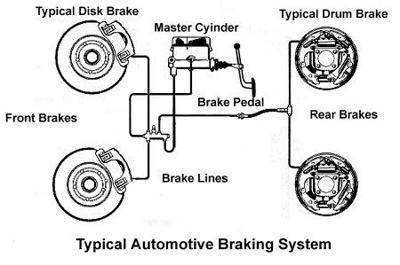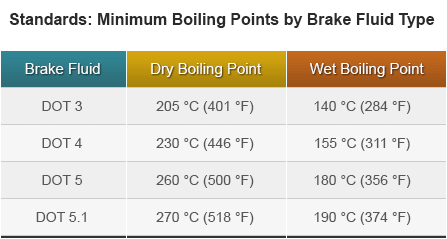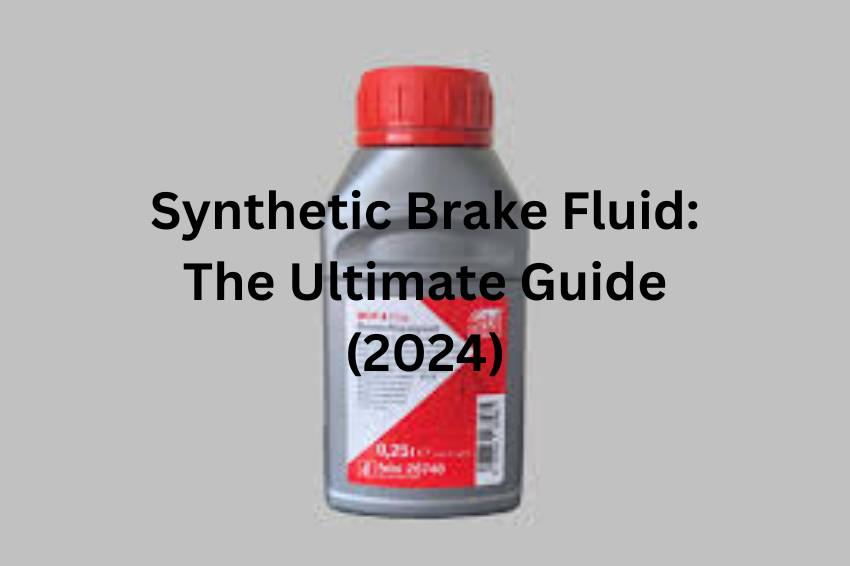This is the most comprehensive synthetic brake fluid guide In 2024.
We’ll explain what synthetic brake fluid is, how it works, and the advantages it offers over regular fluid.
Plus, you’ll learn how to choose the right synthetic fluid for your car and ensure your braking system stays in top shape.
What Is Synthetic Brake Fluid?
Synthetic brake fluid is a specialized type of hydraulic fluid designed for an essential role in your car’s braking system.
Just like engine oil keeps your engine running smoothly, brake fluid transmits the pressing force you apply to the brake pedal down to the wheels.
This allows you to slow down and stop the car safely.
However, there are different types of brake fluid, but synthetic brake fluid uses synthetic components instead of the traditional glycol base found in conventional brake fluid.
This difference offers several performance advantages, which we’ll explore later in this guide.
For now, let’s focus on understanding how brake fluid works in general.
Suppose your car’s braking system is a giant hydraulic press.

When you press the brake pedal, you’re pushing on a piston in the master cylinder.
This force gets transmitted through the brake fluid, which acts like a liquid pushing through tubes (brake lines).
The fluid reaches the calipers at each wheel, where pistons squeeze the brake pads against the discs or drums, ultimately slowing down the wheels.
Since brake fluid is under a lot of pressure during braking, it’s important that it can withstand high temperatures without boiling.
If the brake fluid boils, it creates air bubbles in the system, leading to a spongy brake pedal and a significant reduction in braking performance, which can be dangerous.
Synthetic brake fluid is specifically formulated to have a higher boiling point compared to conventional fluid, offering some key advantages we’ll discuss in the next section.
Synthetic vs. Conventional Brake Fluid: Understanding the Differences
There are two main types of brake fluid available: synthetic and conventional.
While both achieve the same basic function, they differ in their composition and performance characteristics.
Conventional brake fluid is made from a glycol base, a type of alcohol.
Synthetic brake fluid, on the other hand, uses synthetic components, with some key advantages.
Let’s break it down with a table:
| Feature | Synthetic Brake Fluid | Conventional Brake Fluid (Glycol Based) |
| Composition | Synthetic components | Glycol base |
| Boiling Point | Higher boiling point | Lower boiling point |
| Water Absorption | Minimal water absorption | Absorbs water over time |
The key difference in boiling point has a significant impact on braking performance.
When brakes get hot during use, the brake fluid also heats up.
If the fluid boils, it creates air bubbles in the system.
These air bubbles are compressible, unlike brake fluid, which means they can give a spongy feeling to the brake pedal and reduce braking effectiveness, which can be dangerous in situations requiring a quick and firm stop.
Synthetic brake fluid’s higher boiling point helps it resist boiling under high temperatures, leading to more consistent and reliable braking performance, especially during demanding driving conditions.
While conventional brake fluid is less expensive initially, it absorbs water from the environment over time.
Water in the brake fluid lowers its boiling point, reducing braking performance and potentially leading to corrosion within the braking system.
This necessitates more frequent brake fluid changes with conventional fluid.
Benefits Of Using Synthetic Brake Fluid
Synthetic brake fluid offers plenty of advantages over conventional glycol-based fluid, translating into a smoother, safer, and more enjoyable driving experience.
Here are some key benefits to consider:
Improved Braking Performance:
Synthetic brake fluid boasts a higher boiling point compared to conventional fluid.
This means it can withstand higher temperatures without boiling.
As brakes heat up during use, especially during demanding driving conditions like towing, mountain driving, or heavy traffic, conventional fluid can boil and create air bubbles in the system.
These air bubbles are compressible, unlike brake fluid, which leads to a spongy feeling when you press the brake pedal.
This reduces braking effectiveness and can be dangerous in situations requiring a quick stop.
Synthetic fluid’s higher boiling point helps prevent this boiling, ensuring consistent and reliable braking performance even under high temperatures.
Reduced Brake Fade:
Brake fade refers to a decrease in braking effectiveness as the brakes heat up.
This can happen with conventional fluid as it approaches its boiling point.
Synthetic fluid’s higher boiling point helps resist brake fade, allowing your brakes to maintain their stopping power for longer during periods of intense braking.
Longer Brake Fluid Life:
Conventional brake fluid absorbs moisture from the environment over time.
This water absorption lowers the boiling point of the fluid, reducing braking performance.
Because synthetic fluid has a lower moisture absorption rate, it maintains its properties for a longer period, potentially extending the interval between brake fluid changes.
This translates to reduced maintenance costs in the long run.
Safer Braking:
By offering improved braking performance, reduced fade, and a longer lifespan, synthetic brake fluid contributes to overall safer braking.
This is especially important for drivers who engage in performance driving, towing heavy loads, or frequently encounter demanding driving conditions.
While the initial cost of synthetic brake fluid might be slightly higher than conventional fluid, the benefits in terms of safety, performance, and potentially reduced maintenance costs can make it a worthwhile investment for many drivers.
Is Synthetic Brake Fluid Right For Your Vehicle?
The good news is that synthetic brake fluid is generally compatible with most modern vehicles.
However, there’s one key factor to consider: DOT brake fluid classification.

Let’s take a step back.
Brake fluid comes in different classifications, denoted by the Department of Transportation (DOT).
These classifications, like DOT 3, DOT 4, and DOT 5, have minimum boiling point requirements.
This boiling point refers to the temperature at which the brake fluid boils and creates vapor bubbles.
These vapor bubbles can negatively impact braking performance (we discussed this earlier).
Here’s why DOT classification is important:
Your car’s braking system is designed to work with a specific DOT classification of brake fluid.
Using a fluid that doesn’t meet the minimum boiling point requirement for your car (e.g., using DOT 3 fluid in a system designed for DOT 4) could compromise braking performance and safety.
So, how do you know which synthetic brake fluid is right for your car?
- Check your car’s owner’s manual. The manual will specify the recommended DOT classification for your vehicle’s braking system.
- Consult a qualified mechanic. A mechanic can confirm the appropriate DOT classification for your car and advise you on compatible synthetic brake fluid options.
By following these simple steps, you can ensure you’re using synthetic brake fluid that is compatible with your car and delivers the performance benefits you expect.
Choosing The Right Synthetic Brake Fluid
Here are some key factors to consider when making your choice:
DOT Brake Fluid Classification:
As mentioned earlier, DOT classification is essential.
Your car’s owner’s manual will specify the recommended DOT classification for your vehicle’s braking system.
This ensures the fluid meets the minimum boiling point requirements for optimal performance and safety.
Do not deviate from the recommended DOT classification.
Driving Habits And Performance Needs:
Consider how you typically drive your car.
If you engage in everyday commuting or occasional highway driving, a standard synthetic DOT 4 fluid might be sufficient.
However, if you participate in more demanding activities like performance driving, track days, or frequent towing, a higher-performance synthetic fluid with an even higher boiling point (like DOT 4.1 or DOT 5.1) might be a better option.
These high-performance fluids can better resist boiling under extreme temperatures, ensuring consistent braking even during intense driving situations.
Compatibility With Your Vehicle’s Braking System:
While synthetic brake fluid is generally compatible with most modern vehicles, it’s crucial to ensure compatibility with your car’s specific braking system components.
Some high-performance fluids might not be suitable for use with older braking systems designed for conventional fluid.
Refer to your car’s manual or consult a qualified mechanic to confirm compatibility before choosing a specific synthetic fluid.
Cost And Availability:
Synthetic brake fluid generally costs more than conventional fluid.
However, the performance benefits and potentially longer lifespan can make it a worthwhile investment, especially for performance-oriented drivers.
Synthetic fluid is also readily available at most auto parts stores and online retailers.
Synthetic Brake Fluid Maintenance And Replacement
Even though synthetic brake fluid offers performance benefits and a longer lifespan compared to conventional fluid, it still requires some maintenance to ensure optimal braking performance.
Here’s what you need to know:
Maintaining Your Synthetic Brake Fluid:
Regular Visual Checks:
It’s recommended to visually check your brake fluid level every few months, or as frequently as specified in your car’s owner’s manual.
Most brake fluid reservoirs are translucent with markings indicating the minimum and maximum fill levels.
You can usually check the fluid level by simply looking at the reservoir with the hood open.
Importance Of Regular Checks:
Brake fluid absorbs moisture from the environment over time.
This moisture can lower the boiling point of the fluid, reducing braking performance.
Regular checks allow you to identify a potential decrease in fluid level or a change in the fluid’s appearance (it should be a light golden color), which might indicate moisture contamination.
Warning Signs And Replacement:
While synthetic brake fluid lasts longer than conventional fluid, it eventually needs to be replaced.
Here are some signs that might indicate it’s time for a replacement:
- Dark or Dirty Fluid: If the brake fluid appears significantly darker than a light golden color, it could be a sign of contamination or excessive heat exposure.
- Spongy Brake Pedal: A spongy feeling when you press the brake pedal can be a symptom of air bubbles in the brake system, which can be caused by deteriorated brake fluid.
- Recommended Service Intervals: Your car’s manufacturer recommends specific service intervals for brake fluid changes. These intervals can vary depending on the type of fluid, your driving habits, and environmental factors. Consult your owner’s manual for the recommended replacement schedule for your car.
Note: Replacing brake fluid involves bleeding the brakes to remove air from the system. This process can be complex and requires proper tools and techniques. If you’re not comfortable performing this task yourself, it’s recommended to consult a qualified mechanic for professional brake fluid replacement and bleeding.
Safety Precautions When Handling Synthetic Brake Fluid
Synthetic brake fluid, while offering performance benefits for your car’s braking system, needs proper handling to ensure your safety.
Here are some key safety precautions to keep in mind:
Synthetic brake fluid can be irritating to the skin and eyes.
It’s important to avoid direct contact whenever possible.
Wear Personal Protective Equipment (PPE):
When handling synthetic brake fluid, always wear safety gloves and goggles.
Gloves will protect your skin from irritation, and goggles will shield your eyes from any splashes.

Be mindful Of spills:
Accidents happen.
If you spill brake fluid on your skin, rinse the affected area immediately with clean water for at least 15 minutes.
If you get brake fluid in your eyes, flush them with clean water for at least 15 minutes and seek immediate medical attention.
Do Not Ingest Brake Fluid:
Brake fluid is harmful if swallowed.
Keep it out of the reach of children and pets.
If you accidentally swallow brake fluid, do not induce vomiting, and seek medical attention immediately.
Dispose Of Brake Fluid Responsibly:
Synthetic brake fluid should never be disposed of down the drain or in the environment.
It’s considered hazardous waste.
Contact your local mechanic or a hazardous waste disposal center for proper disposal recommendations.
Cost Comparison: Synthetic vs. Conventional Brake Fluid
One of the main considerations when choosing between synthetic and conventional brake fluid is the cost.
Here’s a breakdown to help you understand the difference:
Upfront Cost:
Synthetic brake fluid generally has a higher initial cost per unit (e.g., liter or quart) compared to conventional fluid.
Here’s a table outlining the average prices for different DOT classifications:
| Brake Fluid Type | Dry Boiling Point (°C/°F) | Wet Boiling Point (°C/°F) | Price per 1-liter Bottle |
DOT 3 Conventional | 205°C (401°F) | 140°C (284°F) | As low as $10 |
DOT 4 Conventional | 230°C (446°F) | 155°C (311°F) | $7 – $12 |
DOT 5 Synthetic | 260°C (500°F) | 180°C (356°F) | $12 – $22 |
DOT 5.1 Synthetic | Higher than DOT 5 | Higher than DOT 5 | $15 – $20 |
While the initial cost of synthetic fluid might seem higher, it’s best to consider its potential long-term value, as discussed previously (longer lifespan, reduced maintenance, performance benefits).
Here are some of the additional considerations:
Professional Brake Fluid Flush:
The average cost for a professional brake fluid flush ranges from $70 to $150.
The total cost depends on the type of fluid used and whether you perform the service yourself (not recommended for beginners) or have it done by a mechanic.
Compatibility:
Note that synthetic brake fluids like DOT 5 and DOT 5.1 while offering higher performance, are not compatible with conventional glycol-based fluids like DOT 3 and DOT 4.
Always consult your car’s owner’s manual to determine the recommended DOT classification for your vehicle.
Using incompatible fluid can compromise braking performance and safety.
Synthetic brake fluid isn’t naturally “better” than conventional fluid, but offers advantages like higher boiling points and potentially longer lifespans. However, it also comes with a higher initial cost. Conventional fluid can be suitable for everyday driving, whereas synthetic fluid might be preferable for performance driving or demanding conditions.
Synthetic brake fluid changes are typically recommended every 2-5 years, or as specified by your vehicle’s manufacturer, to ensure optimal braking system performance and safety.
Yes, you can, but proper tools & bleeding techniques are required. Consult a qualified mechanic if unsure to ensure braking system safety.
Mixing synthetic and conventional brake fluid can negatively impact the boiling point, leading to reduced braking performance and potentially causing brake system component damage.
Synthetic brake fluid spills require immediate action. Wear gloves and goggles. For skin contact, flush with water for 15 minutes. For eye contact, flush with water for 15 minutes and seek medical attention. Never ingest. Dispose of used fluid responsibly at a hazardous waste center.
